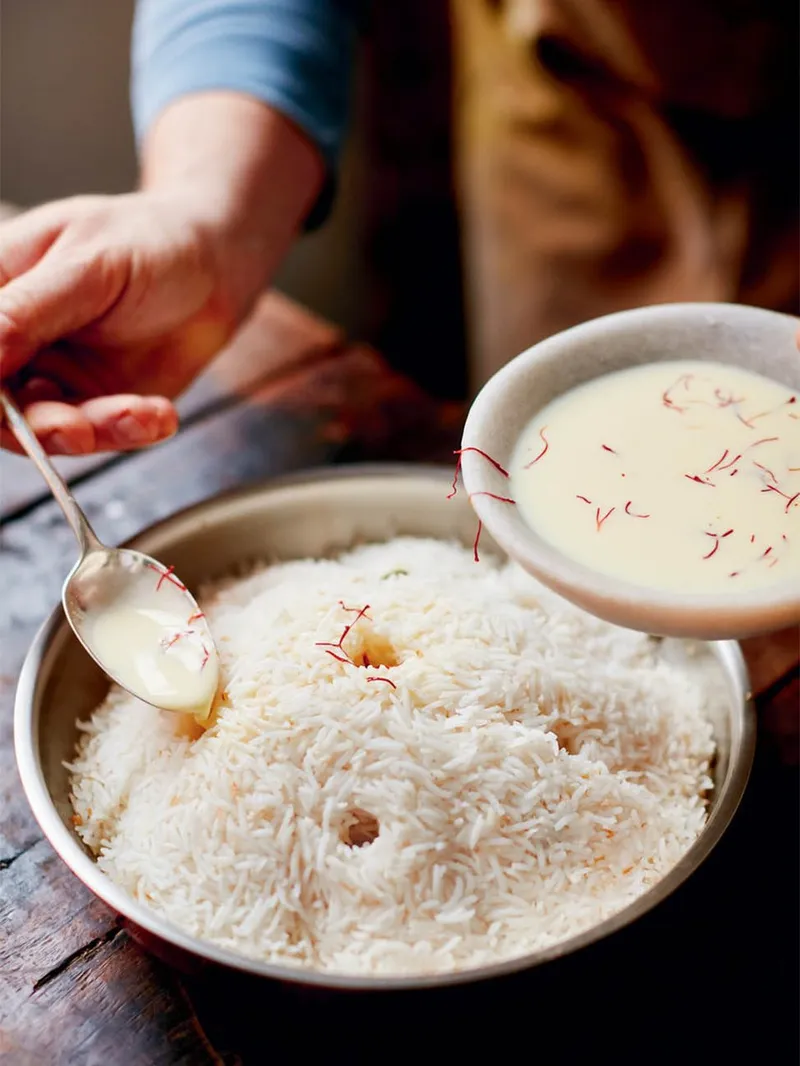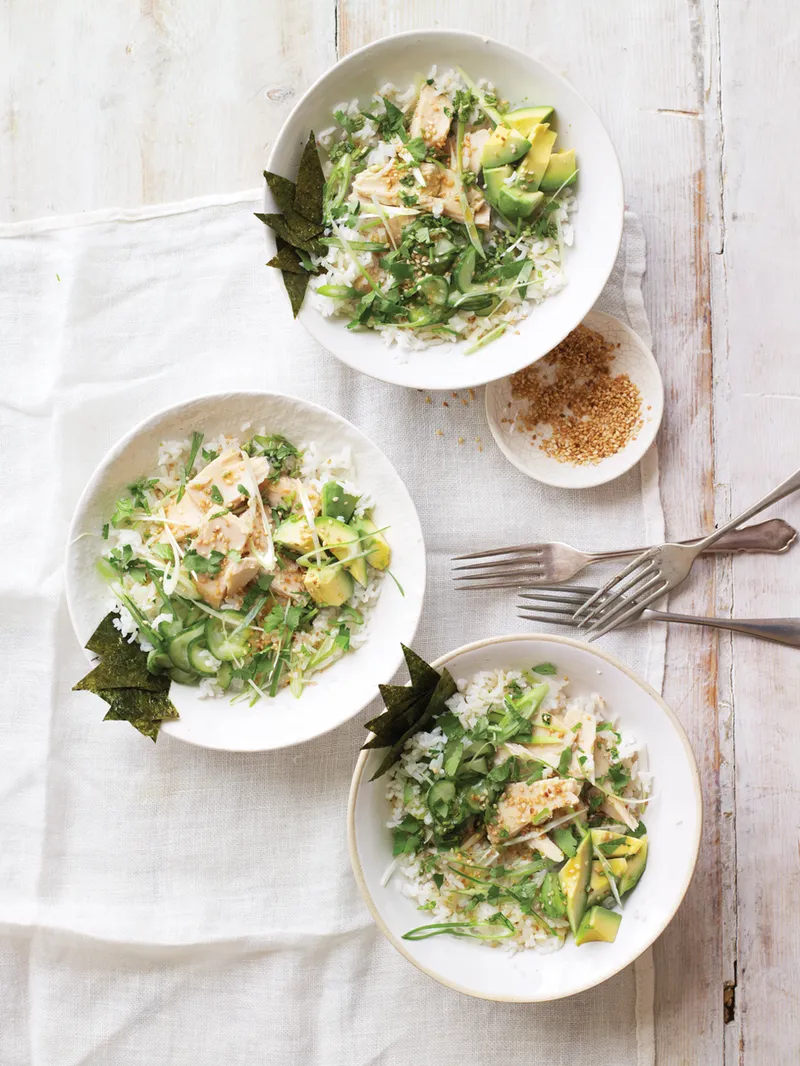Coconut rice - so many ways
- rosemary
- Jul 27, 2023
- 5 min read
"Truly fluffy coconut rice eluded me for years. I felt like I tried every variation possible, but when I lifted the lid, I’d stare at dismay at into a pot of mushy rice, thick with coconut milk scum. Usually with unevenly cooked rice grains – some hard, some overly soft – and almost always with a scorched base." Nagi Maehashi/Recipe Tin Eats

Now this picture is not the stimulus for this post but as soon as I found that my next first recipe was coconut rice I instantly thought of it, and I have put it first because it's so beautiful.
It's a dish from Ixta Belfrage's Mezcla called Sticky coconut rice cakes with turmeric tomatoes. The recipe was made by the author of the website The Salted Potato, who says of it "Wow. Wow. And wow." Yes, not very imaginative I know, but somehow it expresses excitement and joy. I have to say that as soon as I saw this photograph in my copy of this wonderful book I told myself that I would find some reason to make it someday - when David didn't have to eat it. Because he doesn't like coconut. It seems it is also supremely easy and any leftovers can be fried up the next day. Renée Robinson - The Salted Tomato author said of this:
"Those leftover pan fried rice cakes may be one of the best things I’ve ever eaten. I mean, come on! Super crispy on the outside and soft and chewy on the inside is perhaps one of my favorite descriptions in all of the food world. Those textures are number one in my book. Combined with the subtle flavors of coconut milk, ginger, garlic, and scallions, and you’re now talking about something that’s swoon worthy. And while the tomatoes are indeed scrumptious, the rice cakes would be worth making on their own without the accompanying tomatoes if the mood should strike."
And I have to say that her own attempt at the original, and the refried ones look pretty good.
So I'm definitely going to have a go sometime. And Ixta Belfrage herself says that they can be served with a number of other things as well.

But back to the reason I'm talking about coconut rice - this book - the next on my top shelf of old and various paperback cookbooks. In search of first recipes. It was first published in 1969 - David gave it to me as an anniversary present in 1970 - BC (Before Children). And you know I'm not sure I have ever made anything from it because, I suppose, I already had Charmaine Solomon's Complete Asian Cookbook, which although a massive tome and therefore much harder to handle in the kitchen, was more approachable somehow. This may be because Rosemary Brissenden was fundamentally an academic - from Canberra - but probably also because there were no pictures. Maybe by then I was yearning for pictures. I think the lady did a revised and larger edition later in life, although I'm not sure. Is this another one for the street library I wonder. I shall think on it.
However, it's interesting to read her introduction in which she says:

"Amongst the notable cuisines of the world the one which has received least attention is that of South East Asia."
My first reaction was - what about Africa? Surely that's the prime candidate - and it still is, in my opinion - even the Pacific Islands have had more attention, and my second thought was to realise how times have changed since 1969. Today, of course, in Australia anyway, South-East Asian cooking is one of the prime cuisines that we Australians indulge in. Almost every suburb has at least one Thai restaurant, and we have all been to Bali, Singapore, Phuket and Lombok. Well possibly not all of us and possibly not to all of South-East Asia, but probably at least one. Rosemary Brissenden also ignores Myanmar and the countries of the former Indo-China - Vietnam, Laos, Cambodia - saying that they were too influenced by the cultures on their borders - China and India. Korea does not even get a mention, although perhaps it's not quite South-East Asia. Today we can buy most of all those back then unrecognisable ingredients in our local supermarket and if that fails there is always an Asian supermarket within reach. And, of course, there is always online. So today there is no excuse for not being able to make anything from this book. So I should look through and find something before I really consider the street library. Maybe that's my next experiment.
Before I leave the book, however, I should mention that there seems to be some differences of opinion as to the naming of the various coconut rices. The basic Indonesian coconut rice in her book - my first recipe - she calls Nasi Gurih, and indeed there is such a dish but in the subsequent paragraph she maintains that when served at a festival with a number of other things it becomes Nasi Wuduk. Well that seems to be a separate thing and it's also Nasi Uduk (splitting hairs a bit there). Anyway I have come to the conclusion that it's just a regional difference.
Leaving the book and entering the big wide world of coconut rice, what did I find? Well first of all, the basic recipes, which may vary in terms of the spices that are added - or not as the case may be, and also in their cooking methods. Here are a few: Nasi lemak from Adam Liaw - a Malaysian version - indeed it's the national dish according to some; would you believe Jamie Oliver has Fluffy coconut rice, with a slight leaning to Indian flavours I think; and Nagi Maehashi maintains that the secret is to bake it.
Then we move on to the slightly trendy, innovative versions: Jamie Oliver has a version of a Hawaiian poké bowl that he calls Cheat's coconut rice poké bowl; Ottolenghi has Coconut rice with peanut crunch; and on the delicious. website Mike Eggers combines Nasi Lemak and Nasi Ulam into Coconut herbed rice
I did look for Indian versions of coconut rice, and of course there are some, but I had difficulty settling on a recipe or two. Suffice to say they exist and they are spicier - or rather, they contain different spices to the South-East Asian ones. Well I should really be sticking to South-East Asia anyway.
But let's not forget dessert - add sugar and you have dessert: Rice pudding is a bit obvious I suppose, but here I offer you four versions - the first two are from Bill Granger - Black sticky rice with coconut and papaya and Chilled rice pudding with mango and passionfruit; two from Phoebe Wood of delicious. Ginger and coconut sticky rice, and Chilled coconut rice pudding with rhubarb jam. Then there are cakes - sweet ones this time - Sticky rice cake with coconut and pandan from The Spruce Eats, and Bibingka - a Filipino dish on the An Italian the Kitchen website.
Now Rosemary Brissenden maintains that the South-East Asians do not do dessert - they just eat fruit - and so there are no dessert recipes in her book. The rest of us it seems, delight in making desserts with what we consider to be a South-East Asian flavour. Mind you I don't think I find any of the desserts that tempting, although the Bill Granger ones are apparently very popular in his restaurants. It's just a personal opinion. Like David not liking coconut. Taste is a very subjective and individual thing.
I will make those rice cakes with tomatoes one day though.





























Comments